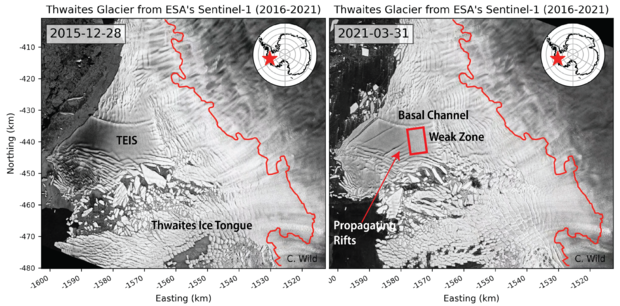"Doomsday" glacier's last-remaining ice shelf could collapse within 5 years, and scientists warn it could rapidly raise sea levels
Antarctica's Thwaites Glacier, commonly referred to as the "doomsday glacier," is so massive that it has the power to raise sea levels by several feet if it melts. Now, scientists are warning that its only remaining ice shelf — a brace that helps prevent the glacier's total collapse — may only last a few more years.
The glacier is about 74,000-square-miles — roughly the size of Florida — and is one of the largest and fastest-melting glaciers in Antarctica, researchers told reporters at a press conference on Monday. The Thwaites Eastern Ice Shelf, the area of concern, makes up one-third of the glacier.
That shelf, researcher Erin Pettit told reporters, is currently "acting like a dam" for the rest of the glacier. But warm water has seeped under the glacier, causing it to melt, and the ice shelf is appearing to "lose its grip" on an underwater seamount that keeps it stable.
Ted Scambos, of the Cooperative Institute for Research in Environmental Sciences, explained that the warm water underneath the glacier is essentially "eating away at the ice shelf."
Researchers said the shelf's ice is "rapidly" shattering. The evidence indicates that the ice shelf's "final collapse" could occur within as little as 5 years.
Such a collapse would likely have a significant impact on the ocean. Today, the ice shelf contributes up to 4% of global sea level rise, but when it collapses, its contribution to sea level rise could increase by as much as 25%, researchers said. If the whole glacier collapsed, it could raise sea levels by more than 2 feet, researchers said.
If it collapses, it's also likely to destabilize other glaciers along the West Antarctic. The Thwaites is a part of the West Antarctic Ice Sheet, an area roughly the size of India. If that sheet were to completely melt — which would take centuries, at least — global sea levels would rise more than 10 feet, according to the International Thwaites Glacier Collaboration.
"[Thwaites Glacier is] the most important place to study for near-term sea level rise," Scambos said. "Within this century, this glacier all by itself could begin to significantly effect sea level rise."
Last year, scientists discovered that warm water had gathered at a "vital point" underneath the glacier. Scientists said at the time that the presence of the warm water suggests the glacier "may be undergoing an unstoppable retreat that has huge implications for global sea-level rise."
And climate change, Scambos said, is a likely culprit in the "dramatic change" expected to happen.
"We're watching a world that's doing things that we haven't really seen before," he said Monday. "The ice is responding in some ways that are surprising us because we are pushing on climate extremely rapidly with CO2 emissions and greenhouse forcing."
Sea levels have risen about 8 inches since 1900, according to NASA, but the rate of the rise is increasing. Last year, scientists warned that the world could expect 5 to 10 feet of sea level rise before the end of the century — reshaping coastlines and forcing hundreds of millions of people around the world to leave their homes.





